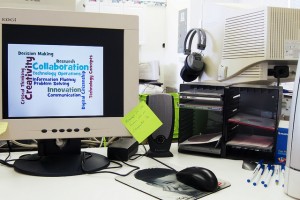This week I’m completing two online graduate courses at The University of Wisconsin, Oshkosh. I am part of their Teaching 2.0 program, entitled: Emerging Technology Meets Progressive Pedagogy. This program looks at the way education is changing, the way students learn, and the way technology can be used to help students collect information, collaborate with other students, and connect to a network that can further their learning.
After a year in the Powerful Learning Practice program, I was excited to find that the university offered graduate credit for my PLP experience. If you’re not ready for a full graduate program, or already have a master’s degree but are seeking new learning, UWOSH also offers credit for PLP’s new e-courses.
One of the UWOSH courses I took this term, “Learning in a Connected World,” was particularly useful. Although I had begun to develop a personal learning network (PLN) before starting the course, this gave me the opportunity to look further into useful tools, ways to engage my students, and applications of these resources in my classroom.
At some point this past school year, I began to truly understand how to change my teaching. The big revelation: It’s NOT about technology. It’s about learning. If we are “integrating technology” just to bring computers (or interactive whiteboards, or cell phones) into the classroom, we’ve got it all wrong. Just using the equipment — or the web tools it allows us to access — isn’t going to lead us or our students to truly connected learning.
We have to look at our overarching goals, and understand how technology is a necessary tool in helping students develop the skills they will need to be successful in the world they will enter.
We have to look at how students like to learn on their own, so we can make learning more enjoyable and engaging in the classroom.
We have to learn what presentation methods or styles of instruction are easy for students to retain, so we can present information in a way that students will hang onto.
We have to look at what students will be expected to know and do in the coming years, so we can prepare them for their future — not ours.
Once we have done this, technology ceases to become a goal and becomes instead a means to a goal — something we use fluidly and regularly, and most of all, with purpose. Not toys, but specialized tools we select for the learning job at hand.
Wondering how to get there?
Here are some tips, based on my experiences:
1. Learn – Part I. Take classes. Read posts or books by leaders in the field, or by educators who are having positive experiences in their classrooms. Do professional development workshops or conferences. Powerful Learning Practice was transformative for me.
2. Learn – Part II. Develop a personal learning network of individuals across the globe who have “been there done that” or want to learn with you. Use Twitter and Twitter hashtags, blogs, or social networking to find educators posting ideas and resources.
3. Collaborate. Find a buddy to learn with, or a mentor to guide you. There are no stupid questions. Support and encourage each other. If you can’t locate one close by, look for compatible colleagues in online communities, including places like Skype in the Classroom, where the audio, video and texting tools can promote sharing.
4. Dive in. Start playing – exploring – trying. You won’t break anything. Find out what is out there, and discover tools that will work with your students. Here’s one good website to get you started .
5. Reflect. Start a blog where you can talk about your experiences. Don’t worry about an audience. In the beginning, a blog’s best purpose is to help you realize what you believe and what is important to you. Here’s mine.
6. Be transparent. As you begin to develop ideas and lessons, share them with your PLN. Give back to those who helped you grow, and to those who are just starting and will benefit from your experience.
7. Be patient. Change is never easy, but do you want to be that teacher who just “doesn’t get it?” You will be less confident for a while as you cover yourself with “the new,” and that’s ok. Things are always changing, which means you will always be learning and growing. Much like your students!
Patti Grayson
Latest posts by Patti Grayson (see all)
- Rethinking Content in the Digital Age - September 4, 2012
- Escape to Summer Reading - June 12, 2012
- Our Skype Adventures: Creating Connected Learners in a Global Classroom - May 29, 2012



i hope. this could be really helpful